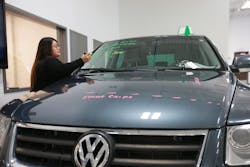What you'll learn:
- Why validation is important
- Why it's more difficult than it used to be to validate a vehicle is repairable
- The three steps to perform in order: pre-scan, measuring, and suspension alignment
Validating whether or not a vehicle can or should be repaired isn’t as easy as it used to be with new vehicle designs and technology taking hold. As manufacturers work to develop safer vehicles using various types of metal and integral unibody construction, the dynamics of each vehicle change as well. We are seeing an evolution of vehicle construction and technology that affect the repair process in major ways. Enhanced Advanced Driver Assistance Systems (ADAS) are changing almost daily and adding to the number of electrical components installed in today’s vehicles. These changes affect not only how you repair a vehicle but determines if the vehicle is even repairable. By taking three steps you can validate the repairability of a vehicle before you write the first appraisal line.
The first step is performing a pre-scan of the vehicle’s systems to identify faults hidden in the electronic components. Every vehicle system — engine, transmission, braking, restraint, and ADAS — is controlled by a computer, and without scanning, you will not know if they are fully functional. It will not benefit anyone to have a nicely repaired vehicle without knowing if all the vehicle systems will function as designed. Pre-scanning followed by diagnosing fault codes and calibrating components is the only way to ensure a repaired vehicle will operate properly after repairs are accomplished.
The second step is measuring, which is often only performed “as needed” but is actually quite necessary to validate vehicle repairability. Vehicle manufacturers are designing vehicles to collapse or crush in some areas and stay rigid in others. These designs enhance vehicle safety but add concerns when determining repairability. Without measuring the structure of a vehicle, there is no way to tell what actually collapsed and stayed rigid during a collision. Vehicle dynamics cause a vehicle to stop suddenly and crush at the impact area, while the opposite end of the vehicle keeps moving to dissipate the inertia. This movement can cause twists to a vehicle that are not visible to the eye but can cause serious structure misalignment. Looking at door gaps and panel alignment can suggest structure alignment is needed but the only true way to know is by structural measurement.
The third step is suspension alignment, and often can be performed with step two if you have the proper attachments. Since suspension alignment is traditionally one of the last processes performed in a vehicle repair, this is a change for some. It will help you identify bent components in wheel assemblies, steering and drive axles to further determine repairability. Finding out that there are expensive suspension components damaged after the vehicle repair is complete has caused significant issues in regard to on-time delivery.
Performing these three steps in this order is probably a stretch for some of you, but I believe if you think back to the last couple of jobs you have repaired, it will begin to make sense. A shop owner told me about a front-end repair with air bag deployment they had just finished. It was sent to a dealer to clear the air bag codes who found several restraint components that needed replacement. We agreed it was not the right time to find out, especially when a pre-scan and review of the OEM repair procedures could have prevented this issue.
Then there was the customer who returned after what seemed to be a minor collision on the left front who was complaining of wind noise at the front doors along with a right rear door that was hard to open. After trying to make several adjustments to correct the issue it was decided to measure the vehicle to determine the cause. After complete structure measurement it was found that the center structure was actually misaligned to the point that the vehicle should not have been repaired in the first place.
Or there was the pickup you were trying to align the suspension on that just had a right bedside replaced where you found a bent wheel and damaged axle on the left side. When you are writing a damage appraisal, it is very easy to focus on the areas with visible damage. Performing a suspension alignment prior to documenting the visible damage will eliminate problems such as this. As I mentioned earlier, a suspension alignment is traditionally the last process accomplished prior to repair completion. In this scenario you will now have a supplement for additional damage with little doubt that the promised delivery date will be missed.
I cannot stress enough the importance of validating vehicle repairability using these three steps. All of the above scenarios were real-life situations I discovered during field visits. Unfortunately, two of the vehicles mentioned above were determined to be total losses. Technically, both were completed with one having been returned to the vehicle owner who later brought it back for the door concerns. Think back to some of the situations you have encountered at your collision center and see how many could have been avoided by validating vehicle repairability. I believe you will find that following these steps will help you avoid issues either during the repair process or after, as well as increase customer satisfaction much more in the long run.




